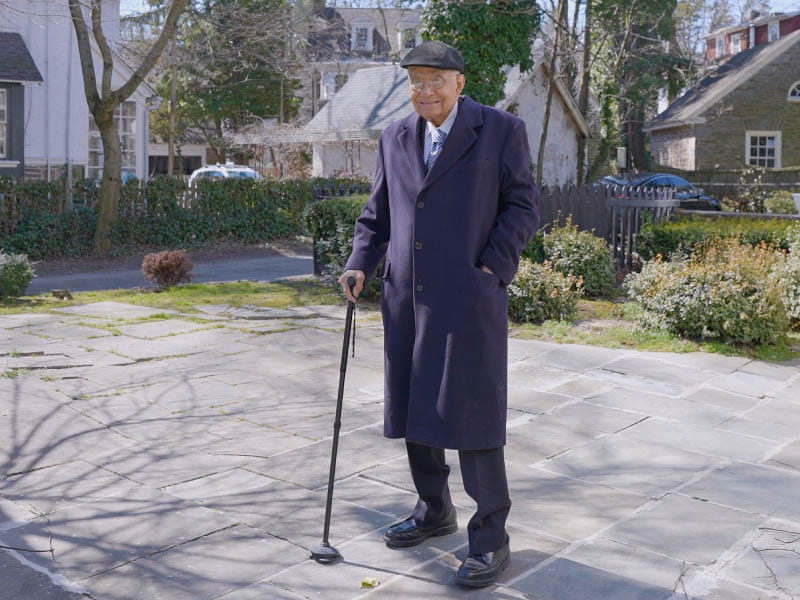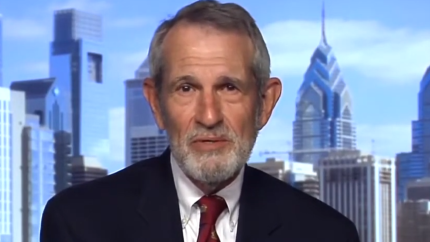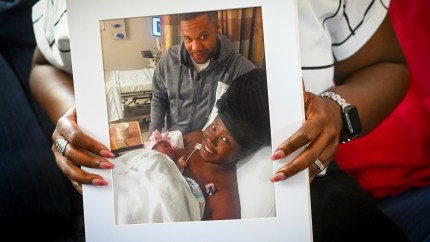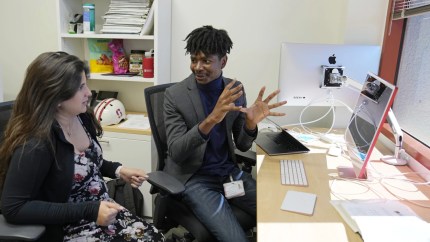Dr. Edward Sawyer Cooper, first Black president of the American Heart Association, influenced food labeling and advanced stroke research
Cooper, 97, became the first Black tenured professor at the nation's oldest medical school, the University of Pennsylvania School of Medicine and the first Black chief of medical services at the U.S. Air Force Hospital.
Soon after his 97th birthday, Dr. Edward Cooper sat down and began writing.
The focus was his career, particularly his work with the American Heart Association. Once typed and printed, his thoughts filled five pages, spilling onto a sixth.
Looking over the printout, Cooper thought it needed more work. He grabbed a black pen and made a few corrections. Some clarifications. Added details. All in clear cursive. The reason he invested so much time and effort? To help the writer of this story – which he did, in more ways than he imagined.
First, there’s the background material itself. Cooper outlined his path to becoming the first Black tenured professor at the nation’s oldest medical school, the University of Pennsylvania School of Medicine, and the first Black president of the AHA with tidbits that didn’t show up in Google searches.
Yet the document represents so much more. The forethought to make it, and the dedication to get it just right sends two distinct messages: How sharp his mind is, and how proud he is of his legacy.

And what a legacy it is.
With the AHA turning 100 this year, the organization is looking back at many of the most influential people in its history. Dr. Edward Sawyer Cooper is clearly among them for the roles he played in advancing stroke care and in encouraging Black people and other underrepresented communities into medicine. Both efforts remain major areas of emphasis for the AHA.
Inspired by a pediatrician and scarlet fever
Cooper’s dad was a dentist, as were two of his uncles. So, it’s no surprise that while growing up in Columbia, South Carolina, he wanted to become a doctor. The twist is his inspiration came from someone else.
Ed was about 7 when his younger brother had scarlet fever. A prominent pediatrician made a house call to treat the child. Ed observed the doctor’s every move. On the way out, the man patted Ed on the head and said, “You’re going to be a good pediatrician.”
Cooper absorbed it as his destiny. His senior year of high school, the yearbook referred to him as “the future famous pediatrician. Also notable is the school year itself: 1941-42, when Pearl Harbor was bombed, plunging the U.S. into World War II.
Another interesting nugget: Cooper graduated at 15. He’d started first grade a year early then skipped fifth grade. South Carolina schools only went to 11th grade back then. Eager to get his career going, Cooper zipped through college, too. He took classes year-round to graduate from Lincoln University, a historically Black college in Pennsylvania, at 18.
Turning that age during World War II meant registering for the draft. Cooper got called in for a physical. By then, he’d been accepted to Meharry Medical College in Nashville, Tennessee, another HBCU. Following his mom’s advice, he showed his acceptance letter to the doctor who examined him.
“That’s fine,” the man said, hardly looking at the letter. Soon, Cooper received reporting orders.
His mom then took the acceptance letter to the head of the local draft board. “We need doctors more than we need privates,” the head of the draft board said. Cooper’s military obligation was deferred until after his medical training.
Finding the truth about heart attacks in Black patients
At Meharry, Cooper became fascinated with every aspect of the human body. Suddenly, treating kids seemed limiting. Wanting to treat patients with a broader range of diseases, he decided to become a specialist in adult internal medicine.
One day, a professor showed Cooper an article in a scientific journal. It said heart attacks were rare in Black patients. “What do you think about this?” the professor asked Cooper. “Why don’t we look at it and see what the situation is?”
In what became his first research project, Cooper tracked patients at his local hospital for several months. He found what every major research study since has found. “There was no shortage of heart attacks among Hubbard Hospital’s Black patients,” he wrote in the document prepared for this story.
The next step after medical school was an internship. Cooper was such a great candidate that he had offers from hospitals in Chicago, Cleveland, Philadelphia and Jersey City, New Jersey. Philadelphia was a two-year program; the others were one. Philadelphia was unpaid; the others were paid.
Yet Philadelphia had something else going for it.
As a child, Ed loved spending Saturdays in his dad’s office. When he wasn’t sterilizing equipment or watching how gently his dad treated patients, he liked looking at the diplomas, plaques and such on the walls. One commemorated an externship at Philadelphia General Hospital, the same facility now trying to lure him.
Still, those were some serious tradeoffs. He called his dad to discuss it.
“Philadelphia General – no question about it!” his dad said. To help seal the deal, dad offered to continue paying Cooper’s expenses, just as he’d done for college and medical school.
There’s a postscript to this anecdote. Before turning down the other three hospitals, Cooper thought about which of his Meharry pals could handle those jobs. He encouraged them to essentially take his place. Sure enough, each slot went to one of his buddies. In retrospect, this was the start of his effort to boost the careers of Black doctors.
Philadelphia General was among the oldest and largest hospitals in the country. While it brought in 50 interns per year, the two-year cycle meant 100 were always on staff. Cooper was the third Black intern in PGH history and the only Black person in his 50-person cohort.
The hospital’s patients were pretty much split between Black and white. But while on a neurology rotation, Cooper noticed most stroke patients were Black. He noticed a few more trends. Most of the strokes were hemorrhagic, meaning they were caused by bleeding in the brain. And most hemorrhagic stroke patients had uncontrolled hypertension, which at the time was only a known risk factor for heart disease.
Recommended Stories
Cooper wondered: “Is this a cause-and-effect thing? Or is it just a coincidence?”
Those seemed like important questions. Because with little to no treatment available, outcomes were miserable. About half the stroke patients died, and most survivors had severe disabilities.
A pact with God
Soon, however, Cooper faced his own life-or-death drama. During that rotation, Cooper went an entire weekend shift without sleeping more than a full hour. He left feeling dizzy and feverish. Worried, he went to the infirmary. His temperature was 105 degrees.
Cooper had been at PGH long enough to know who the best doctors were. He asked to be treated by them. Even they couldn’t figure out what was wrong. Trial and error with medicines kept coming up with errors. His fever continued to rage. He began hallucinating. Then came a vivid nightmare featuring coffins, skulls and crossbones. He awoke thinking, “I guess this is it.”
He figured there was only one thing left for him to do.
Growing up, Cooper got on his knees and prayed before getting in bed each night. In college, roommates teased him for doing it, so he stopped. Now it was time to again appeal to the heavens. Cooper looked up and said: “Good Lord, if you help me through this, I assure you I will do everything I can to help those poor patients with stroke.”
Around the same time, doctors solved the medical mystery. Cooper had an invasive type of flu that also caused pneumonia. Soon, the correct antibiotics were flowing through his body. Days later, Cooper’s temperature was gone. Several valuable things remained: An appreciation for what it’s like being a patient. A special bond with several of PGH’s top doctors. And a promise to keep.
Cooper finished his internship and residency at PGH in 1954. Now married to Jean – herself a doctor – and with a daughter, it was time to fulfill his military obligation. The family left Philadelphia for the Philippines. Cooper spent two years as the first Black chief of medical services at the U.S. Air Force Hospital.
Those top docs at PGH invited him back for a cardiology fellowship. When he and Jean returned, they were up to four kids.
After the fellowship, Cooper became an attending physician and faculty member at the University of Pennsylvania Medical Services. This meant he could do research, see patients and teach medical students. The hospital also allowed him to become the first program director at Mercy-Douglass Hospital, Philadelphia’s only Black hospital.
In the late 1960s, Penn received a $1 million federal grant to set up a stroke research center at PGH. Cooper, a co-founder, served as its co-director for 10 years until the hospital closed. He then moved to the Hospital of the University of Pennsylvania, eventually becoming a member of its board of trustees.
In 1972, Penn made Cooper a tenured professor, an honor the school had never given to a Black doctor. Breaking that barrier was nice; nicer was one of the perks: free tuition for his kids. “That,” he said, “was a big relief.”
Examining MLK and ‘being ‘guarding’ Harry Belafonte
Over four decades of practice, Cooper’s body of work included countless scientific papers, trainees and patients. Yet the case he’s asked about most involves a simple physical. Because the patient was the Rev. Dr. Martin Luther King Jr.
In 1958, a woman stabbed King in the chest with a 7-inch letter opener during a book signing. Doctors spent hours carefully removing the blade. He healed amazingly well. A few years later, he wanted to have the scar smoothed out by a friend who was a dermatologist at Mercy-Douglass. While in the hospital, King requested a physical. The dermatologist said, “I know exactly the guy you need to see.” Cooper, of course.
Today, a full workup takes hours. Back then, it took days. King spent them working from his hospital room. One day, he hosted a meeting with Harry Belafonte, a major celebrity and civil rights leader, to discuss an upcoming event. Before Belafonte arrived, King told Cooper, “I want you to get somebody to meet him and bring him up here.” Cooper gladly did it himself. When Belafonte was ready to leave, Cooper escorted him back down.
Surprise! Folks had heard that Belafonte was there. The lobby was packed with fans. Cooper was a doctor, not a bodyguard. He didn’t know what to do. Good thing Belafonte did.
“Don’t make any sudden moves,” he told Cooper. “Just walk smoothly and don’t say anything. We’ll go out the back door and I’ll sign some autographs.”
A few years ago, a writer working on a biography about Cooper called Belafonte to verify the story. He remembered it, all right, laughing and telling the writer, “Dr. Cooper got a little skittish.”
Bringing Black people into the medical field
Around the time Cooper joined the Penn faculty, colleagues recommended he get involved with the local branch of the American Heart Association. The AHA’s professional membership is broken into clusters called councils, each based on a scientist’s specialty. Cooper joined the Stroke Council.
In the 1960s and ’70s, he served long stints on the local board of directors. In 1982, he joined the national board of directors. That same year, he became chair of the Stroke Council. The AHA’s mission statement then was: “The reduction of premature death and disability from cardiovascular diseases.” Anytime Cooper heard it, he’d quickly chime in, “and stroke!” – always with a friendly smile.
In 1985, while Cooper was still on the national board, the AHA amended its mission statement to add those two words.
Cooper also volunteered with the National Medical Association, the largest organization representing Black doctors and patients. In the late 1960s, the NMA president asked Cooper to create a pipeline from HBCUs to medical schools. Recruiting Black medical students wasn’t just the right thing to do. It was smart business because the creation of Medicare and Medicaid tied federal funding to desegregation in health care.
Cooper became head of the NMA’s Talent Recruitment Council. By the late 1970s, the number of Black medical students nearly doubled from the previous decade. Slow, steady growth has continued. Black doctors went from making up 2.2% of the field in 1977 to around 5.7% today.
Within the AHA, Cooper also became a leader in the push for equal representation. In his document for this story, Cooper recalled a meeting in which an AHA president was trying to establish a Women and Minority Leadership Committee. It wasn’t going well, he wrote, “until she called on me for comments. … The vote suddenly was positive, and the resolution passed.”
In the summer of 1992, Cooper became the AHA’s first Black president. He also believes he was the first president to come up through the Stroke Council. Funny thing is the hallmark of his tenure turned out to be food nutrition labels.
The U.S. Department of Health and Human Services was pushing for standardizing the information on nearly all packaged foods while the Department of Agriculture was pushing against it. The HHS leader had been friends with Cooper for many years. During the final stages of negotiations with President George H.W. Bush, the HHS leader came up with a strategy that looped in Cooper and the AHA.
“I thought it would work – and it did,” Cooper said. In his final weeks in office, Bush pushed through the changes, requiring the information we’re now accustomed to seeing.
Mostly, though, Cooper used his one-year tenure at AHA to tour the country, touting the subjects he was most passionate about: inclusion and stroke. Today, both areas are pillars of the organization’s focus.
In addition to encouraging and emphasizing better representation within medicine, the AHA has maintained a strong focus on health equity – from an early emphasis on social determinants of health to a 2021 commitment to 10 bold actions to address barriers to health equity by 2024. Also of note, the AHA has since had four Black presidents, including the first woman; the incoming leader will be the fifth.
As for stroke, the AHA takes great pride in its role of advancing treatment and awareness. In 1998, the organization’s Stroke Division became the American Stroke Association. Also, a scientific journal named Stroke launched around the same time as Cooper’s presidency and has established itself in academic circles. And the AHA has since had two neurologists as president.
When his term ended, Cooper promised Jean he would wrap up his career. It took him until 1996 to unspool all his commitments. “And once I retired,” he said, “I retired!”
Nearly three decades later, the University of Pennsylvania Perelman School of Medicine has a professorship named for Cooper. A Penn Internal Medicine clinic carries his name. Since 2009, the AHA has presented the Edward S. Cooper Award to a researcher, medical professional or organization whose many outstanding contributions to the Philadelphia community exemplify the best of humankind.
A family of eight physicians
Yet when asked what part of his legacy he’s most proud of, Cooper talks about his family.
Ed and Jean were married for 55 years, until she died in 2006.
Their daughter Lisa Hudgins is a pediatrician, and another daughter, Jan Cooper, practices internal medicine. (Put another way, Lisa followed her dad’s original path, while Jan followed the path he took.) A son, Charles Cooper, is a psychologist. Another son, E. Sawyer Cooper Jr., died of Hodgkin lymphoma at age 30.
Three of Cooper’s four grandchildren are doctors. So is one of their spouses. Cooper’s oldest great-granddaughter wants to be a doctor, too. She may only be 6 but, remember, that’s about the age Ed was when he chose a career in medicine.
Ed and Jean Cooper clearly set a powerful example. It went beyond their professional life. It was mostly the kind of people they were. All of it is captured in the home he bought early in his PGH days, a three-story house that oozes love, joy and history.
Sitting on his living room sofa, Ed can see photos dating back to his grandparents and forward through all his offspring. Behind him is a figurine of King. On the corner of a coffee table diagonal from him sits a photo of former President Barack Obama. On the other end of the first floor, there’s an office filled with awards, certificates and photos. One shows Ed during his AHA presidency alongside then-President Bill Clinton and Vice President Al Gore.
Just as this visit began with Cooper providing the telling detail of the six-page document, he unintentionally shared another insightful nugget while saying goodbye. Sitting at the base of a U-shaped staircase, Cooper described his plans for the next few hours.
He was about to have lunch on the second floor. To get there, he would ride an electric chair. The lift is a begrudging concession to age – and one he made only recently.That’s not the telling detail, though. After lunch, Cooper planned to take his afternoon nap in his favorite spot.
To get there, he would walk the stairs.
Never miss a beat: Get our daily stories straight to your inbox with theGrio’s newsletter.








